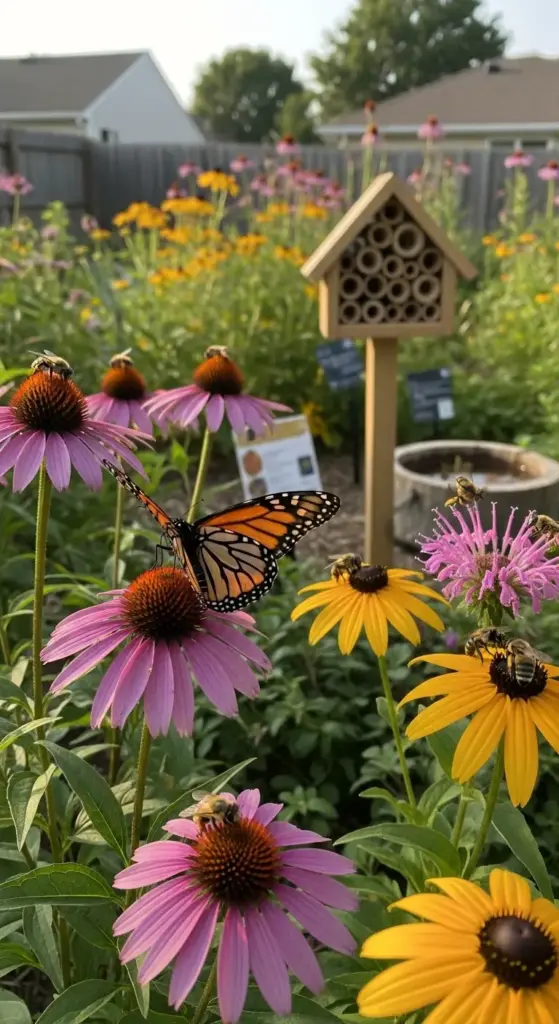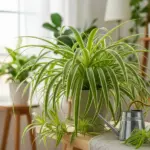3. Pollinator Paradise: Eco-Friendly Gardens That Give Back

The day I watched my first monarch butterfly emerge from its chrysalis in my backyard changed everything. I was officially hooked on pollinator gardening.
Before that magical moment, I honestly didn’t think much about native plants or bee habitats. My garden was pretty, but it wasn’t really helping anyone except my Instagram feed.
Regional Native Superstars That Actually Work
Here’s what nobody tells you about native flower selections – they’re not all created equal, even within the same region.
Pacific Northwest gardeners should absolutely start with Oregon grape and salmonberry. These natives provide early nectar when bees are desperately hungry after winter.
I learned this lesson the hard way when I planted beautiful non-natives that bloomed at all the wrong times. Timing matters more than beauty when you’re feeding pollinators.
East Coast natives like purple coneflower, wild bergamot, and New England aster create an incredible pollinator buffet from summer through fall.
In the Midwest, prairie dropseed, wild lupine, and black-eyed Susan form the backbone of any serious butterfly garden. These tough natives handle everything from drought to flooding.
Suburban Butterfly Highways
My suburban backyard became a pollinator paradise once I stopped thinking like a traditional gardener and started thinking like a wildlife habitat designer.
Butterfly habitats need three things: nectar plants, host plants, and shelter. Most people only focus on the pretty nectar flowers and wonder why butterflies don’t stick around.
I created butterfly corridors by planting native milkweed for monarchs and spicebush for spicebush swallowtails. Host plants are where butterflies actually lay their eggs.
Bee habitats are different – they need diverse flower shapes and bloom times. I plant flat flowers like yarrow for small bees and tubular flowers like bee balm for bumblebees.
Kid-Friendly Garden Magic
Adding educational garden elements turned my pollinator garden into the neighborhood’s favorite outdoor classroom.
I installed a simple bee observation house made from bamboo tubes in a wooden frame. Kids love watching the native bees come and go.
Butterfly puddling stations are basically shallow dishes with sand and water. Children get so excited watching butterflies “drink” from these mini oases.
My caterpillar nursery area is just a section where I let host plants grow wild. Kids check daily for new chrysalises and emerging butterflies.
Plant labels with fun facts make every garden visit a learning opportunity. “This milkweed feeds monarch caterpillars!” gets kids way more excited than just “Asclepias speciosa.”
Bloom Succession That Actually Works
Seasonal bloom planning was my biggest challenge until I started keeping a simple garden journal.
Early spring needs crocuses, wild ginger, and bloodroot to feed the first hungry bees. These native early bloomers are absolute lifesavers for overwintering pollinators.
Summer succession requires overlapping bloom times. I plant early summer natives like wild columbine, mid-summer powerhouses like purple coneflower, and late summer champions like goldenrod.
Fall blooming asters are crucial for migrating monarchs. I learned this after watching dozens of butterflies desperately searching for nectar in my neighbor’s barren October garden.
The secret is having something blooming from March through November. Continuous nectar sources keep pollinators healthy and your garden buzzing with life.
Organic Everything (Because It Matters)
Switching to organic gardening supplies wasn’t just trendy – it was essential for pollinator health.
Natural pest management starts with accepting that some leaf damage is normal in a healthy ecosystem. Perfect plants often mean dead beneficial insects.
I use beneficial nematodes for grub control and diatomaceous earth for slug problems. These organic solutions target pests without harming pollinators.
Companion planting became my favorite pest control method. Marigolds, nasturtiums, and herbs naturally repel harmful insects while attracting beneficial ones.
Compost tea feeds my plants without synthetic fertilizers that can harm soil microorganisms. Healthy soil creates healthy plants that resist pests naturally.
Capturing the Magic on Camera
Garden wildlife photography turned into an unexpected passion once my pollinator garden took off.
Early morning is absolute gold for butterfly photography. They’re slower when it’s cool, and the light is incredible.
I keep my camera on macro mode and move very slowly. Bee photography requires patience – they’re constantly moving between flowers.
Action shots of butterflies landing or bees collecting pollen tell better stories than static flower photos. I use burst mode to capture those split-second moments.
My best tip? Focus on the eyes. Whether it’s a butterfly or a bee, sharp eyes make the photo come alive.
Seasonal documentation of the same plants shows the incredible transformation from bare soil to pollinator paradise. These before-and-after sequences are incredibly rewarding to look back on.
Ready to maximize your small space with stunning vertical displays? Our next section reveals how to create breathtaking flower walls that transform tiny urban yards into lush garden sanctuaries. Discover the climbing plants and DIY structures that will make your neighbors seriously jealous!









GIPHY App Key not set. Please check settings